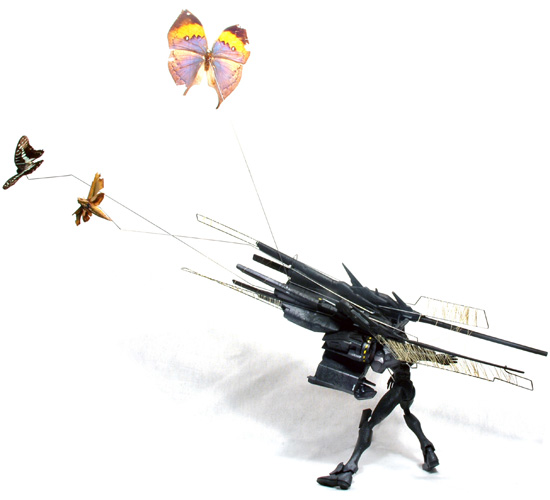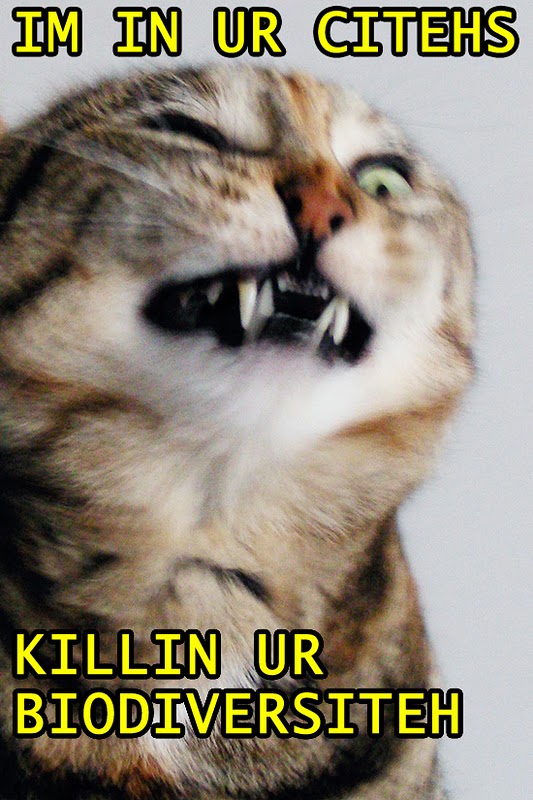
Here are some bits collected from the news ticker.
There is a rhinoceros foraging on the banks of the Jones Falls River in Baltimore, Maryland.
Is China becoming the global fashion capital of apian couture?
Kitteh urbanism I: “Scientists at the University of Illinois and the Illinois Natural History Survey recently attached radio transmitters to the adjustable collars of 18 pet and 24 feral cats in southeastern Champaign-Urbana and tracked the animals by truck and on foot for more than one year. The research, published in the Journal of Wildlife Management, shows that pet cats maintain a rather lazy existence: they spent 80 percent of their time resting. They devoted another 17 percent to low-activity pursuits such as grooming and only 3 percent to high-activity pursuits such as hunting. Unowned cats rested just 62 percent of the time and spent 14 percent, mostly at night, being highly active. Feral cats roamed far more widely than researchers had expected: up to 1,351 acres. In contrast, pet cats stayed within an average of about five acres of home.”
Kitteh urbanism II: “Cats in several suburbs of Sydney will be ordered to curl up inside from dusk to dawn under a curfew that hopes to curb overnight attacks on native wildlife.”

The Round Butte Selective Water Withdrawal Tower is “a 270′ underwater tower designed to perform multiple functions that assist challenged fish migration within a dammed river system.”
On its second trial run this summer in Portland, Oregon, the Goats on Belmont project is “merging urban ecology experimentation with land management strategy and urban event.”
On animal webcams: “From amateur setups near backyard bird nests to elaborate video systems chronicling the daily activities of sharks and polar bears, live webcams of animals show us birth, romance, skullduggery and death — animals behaving like animals 24/7. Birds of prey such as hawks and eagles are particularly popular, but with a little searching, you can watch the day-to-day goings-on of squirrels, meerkats, bears and even chickens.”

Coyote at the Kitchen Door: Living with Wildlife in Suburbia by Stephen DeStefano: “In 2006, a coyote named Hal turned up in Central Park, evading park rangers and the NYPD for two whole days while underscoring the coyote’s increasing prevalence in the population-dense Northeast. As adaptable as they are surreptitious, coyotes particularly love the suburbs, where food is abundant and natural predators rare. For wildlife biologist DeStefano, the coyote is thus an inspirational symbol of nature’s resilience: a wild animal that has learned to thrive amid human sprawl without our consent and in spite of our perennial efforts to banish them from our midst. Narrating the travels of a plucky female coyote, the author explores humans’ evolving relationship with nature and the violence of our light, noise, and traffic. Along the way, he offers us a glimpse at his own restless spirit, born in the Boston suburbs but drawn to the desert Southwest; resentful of human wastefulness yet exhilarated by the open road. DeStefano’s willingness to probe his own ambivalence about the possibilities of coexistence with nature allows this selection to be about much more than just wild canines.”
One of the stars of CSI: Wildlife is Carol Meteyer, a forensic veterinarian who “solves cases of mysterious wildlife death using advanced forensic skills to help prosecute people who kill animals in violation of federal law.”
Fashioning Feathers, an exhibition that closed last month at the University of Alberta, Edmonton, but lives on as an online catalogue, looks into “the complex geographies of collection, production and consumption behind the making of such ‘feather fashions’. From the hunting and killing of birds in their natural habitats, to their processing in metropolitan plumage sweatshops and crafting by professional and amateur milliners, to their becoming adornments on the heads of women in Europe and North America.”
Here's an excerpt from an interview by The Dirt with Lyanda Lynn Haupt, author of Crow Planet: Essential Wisdom from the Urban Wilderness:
The Dirt: You say most of us, unwittingly, live in a zoopolis, a multi-layered place where the city meets the zoo, an overlap of human and animal geographies. How then can landscape architects design cities so that humans and different animal species can better co-exist? Do we even want to design cities so they are more livable for species like crows?
Lyanda Lynn Haupt: Oh, we definitely don’t want more crows! The role of the landscape architect in creating cities livable to creatures in the more-than-human world involves the opposite—working to structure human habitations that are more hospitable to a greater variety of native animals, and less hospitable to species such as crows. There is no one way to do this. For decades the wisdom from conservation biology has involved the preservation of large forest fragments—the bigger the better, and this was viewed as the most important thing. And it’s true—leaving remaining woodlands undisturbed is essential. But we’re learning that there are other elements at play—when we decrease impervious surfaces, increase the number of trees (especially native trees, including conifers where appropriate), and work to create a multilayered botanical structure, more native forest birds turn up, even in urban places.
Stay tuned for more.
Post a Comment —
Comments on posts older than a week are moderated —